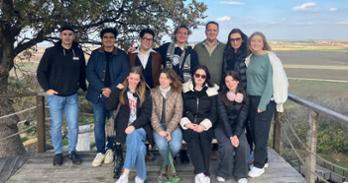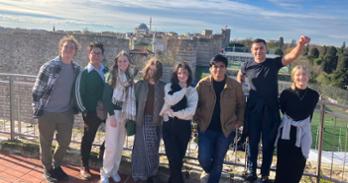The Culture of Eastern Orthodoxy: Byzantine Influences on Russia and Eurasia

In December of 2023, the Carmel Institute sponsored a class trip to Istanbul for a group of students from American and George Mason universities. It explored the legacy of Byzantium and Byzantine Orthodoxy in Eurasia.
Before departing the US, the students read Bettany Hughes' Istanbul: A Tale of Three Cities as a general introduction to the history of the Byzantine Empire and Constantinople. Homer’s legendary Iliad was an optional reading. The class combined discussions of the books with visits to churches, museums, mosques, art galleries, and archaeological sites in Istanbul and beyond. In the process, students explored the history of the Byzantine Empire, the evolution of Eastern Orthodoxy, and interconfessional relations throughout medieval and modern history. Dr. Onur İşçi of Kadyr Has University in Istanbul also joined the group on select museum visits, guided some of the tours, participated in discussions, and gladly answered many questions while touring Istanbul.
Carmel Institute director and professor of history Anton Fedyashin guided the students through museums and urban explorations, and led daily discussions based on the readings. In the process, the students learned to contextualize written texts through museum exhibitions, artistic representations, religious symbolism, and archaeological interpretations. The urban tours related architectural styles to religious, philosophical, and artistic trends. The class also introduced the students to the impact of deep cultural structures on spiritual and visual expressions of medieval and early modern societies.
On the first full day of the trip, Dr. Fedyashin gave the students a tour of the Istanbul Archaeological Museum as an introduction to geopolitics and history of the Achaean civilization and the classical city-states of Greece, one of which, Megara, established the colony of Byzantion and influenced its evolution towards Constantinople. Exploring the artistic styles that dominated the Eastern Mediterranean region from the Archaic to the early Byzantine periods, the group discussed the literary, philosophical, and geopolitical trends leading up to the split between the Western and Eastern Roman Empires. The students also reflected on the intellectual and spiritual legacy of the classical era that the Christian world would inherit, coopt and, in some cases, suppress. After lunch, the group visited a remarkable marvel of early Byzantine engineering, the fifth-century Basilica Cistern, and discussed the important contribution of Roman engineering to the development of Mediterranean and Eurasian civilizations. Touring the museums and the city on the way there and back, the group walked almost ten miles on the first day.
 On the second day, the group traveled to the archaeological site of Troy on the Aegean coast. The drive there took the students across the Hellespont and the group had lunch in the historic town of Çanakkale not far from which the Ottoman Empire defeated the amphibious invasion by the Entente powers during the Great War. The students then toured the new Troy Museum and the archaeological site. The discussions that day focused on the role of the Trojan War in Roman, Byzantine, and Christian Orthodox self-definition. Once it conquered the Macedonian and Greek territories and turned them into provinces, the Roman Republic began to emphasize Aeneas’s role as the city’s founder. Eastern Roman Emperor Constantine the Great emphasized the connection between his new capital Constantinople and Troy by allegedly encasing the Palladium statues that Aeneas was supposed to have carried with him from Troy within the base of the famous Constantine Column, which still stands close to Istanbul’s Grand Bazaar.
On the second day, the group traveled to the archaeological site of Troy on the Aegean coast. The drive there took the students across the Hellespont and the group had lunch in the historic town of Çanakkale not far from which the Ottoman Empire defeated the amphibious invasion by the Entente powers during the Great War. The students then toured the new Troy Museum and the archaeological site. The discussions that day focused on the role of the Trojan War in Roman, Byzantine, and Christian Orthodox self-definition. Once it conquered the Macedonian and Greek territories and turned them into provinces, the Roman Republic began to emphasize Aeneas’s role as the city’s founder. Eastern Roman Emperor Constantine the Great emphasized the connection between his new capital Constantinople and Troy by allegedly encasing the Palladium statues that Aeneas was supposed to have carried with him from Troy within the base of the famous Constantine Column, which still stands close to Istanbul’s Grand Bazaar.
The group started the third day with a tour of the classical and medieval world’s largest Orthodox cathedral, the Hagia Sophia. Turned back into a functioning mosque recently, it remains open to tourists between prayer times. Even though it is 1,500 years old, its sheer size and beauty continue to stun. The students then toured the official residence of the Ottoman sultans, the Topkapi Palace Museum, and the oldest standing Orthodox church in Istanbul on the premises of the complex, the Hagia Irene. After lunch and a discussion of the fall of Constantinople to the Ottomans in 1453, the group walked across Sultan Ahmed Park to visit the Sultan Ahmed Mosque, often called the Blue Mosque for the stunning white-and-blue tiles that adorn its interior. Dr. Fedyashin then took the students on a tour of the remnants of the ancient hippodrome with its three remaining historic columns, including the unique private hippodrome museum in another cistern. Over dinner, the group discussed Hughes’s chapters about the building of Hagia Sophia and the fall of Constantinople.
The fourth day saw the students touring the Istanbul Naval Museum and then eating in the popular Beşiktaş market and discussing their impressions. The group then followed Dr. Fedyashin on an extensive tour of Dolmabahçe Palace, the European-style residence of the last Ottoman sultans, and the site where Kemal Atatürk died in November of 1938. Then the group proceeded to explore Istanbul’s historic Grand Bazaar.
The fifth day began with a visit to the Tekfur Palace, which stood along the Theodosian Wall of Constantinople. The wall and adjacent imperial palace marked Constantinople’s periphery in 1453, when the Ottoman army attacked the Byzantine capital. Dr. Fedyashin gave the students a tour of the site where the last Byzantine Emperor Constantine XI is said to have taken leave of his family and court for the last time before joining his capital’s defensive forces. Recently restored and reopened, the Tekfur Palace offers spectacular views from its rooftops upon the extent of the city as it was in the fifteenth century. The group walked along the remaining section of the wall with a stop to see one of the rare monuments of Byzantine architecture, the Chora Church. After lunch, the group continued their three-hour walk back to the historic district. It passed under the Valentinian Aqueduct, a marvel of Byzantine engineering, and visited several historic mosques designed by renowned Ottoman architect Mimar Sinan.

The group started the sixth day by taking the city ferry to the Kadiköy district to explore the history and architecture of the Asian side with its Orthodox churches and mosques with Dr. Onur İşçi as a guide.
The students spent the last morning in Istanbul exploring the religious buildings on Istiklal Avenue and then made their way to the airport for their long journey to Washington, DC.
